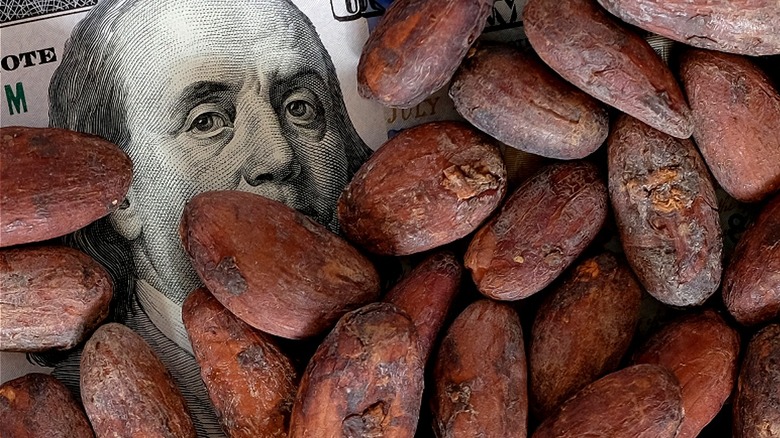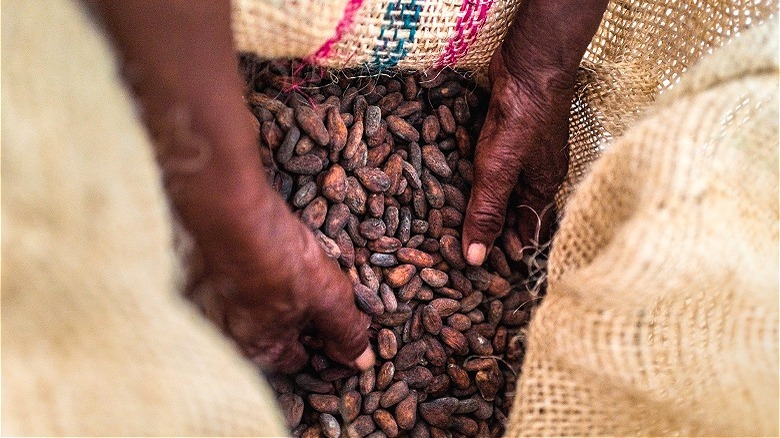Understanding The Sharp Rise Of Cocoa Prices And How It Affects You
If you're someone with a sweet tooth you might soon be facing another, less pleasant, experience with your favorite candy bar: sticker shock. According to CNBC, cocoa has more than tripled in cost in the last year, with prices currently up 129% in 2024. While most of the large chocolate companies have, so far, been able to absorb and hedge some of these price increases (rather than passing it on to consumers), that will soon change. As Paul Joules, a commodities analyst at Rabobank, explained to CNBC, "The worst is still yet to come." In addition to ongoing supply issues, financial speculators have further complicated the cocoa market, ensuring that companies will begin offsetting their costs onto consumers.
It's important to realize that, historically, the chocolate industry has operated on inexpensive crops and even more inexpensive labor. This has kept cocoa prices relatively steady for much of the last decade, with the global benchmark price generally sitting around $2,500 per metric ton. However, supply and production issues began pushing prices up, with December 2023 prices reaching $4,200 per ton. While this was bad enough already, financial speculators began artificially pushing the price of cocoa up further, reaching a high of $11,000 per ton in mid-April 2024. Its prices have remained volatile since then, dropping 30% in a two-week period before once again hiking back up. Let's dive into the factors presently plaguing the cocoa bean market, and explore just how much more your favorite chocolate bar will cost you (or how much less you'll get thanks to shrinkflation).
Production issues
For those who might not know, two West African countries — Ivory Coast and Ghana — produce 60% of the entire world's cocoa supply. However, a combination of bad weather and plant disease has led to several bad seasons in a row for cocoa crops. This, in turn, has caused an increasing supply crisis as cocoa producers are unable to meet global demand. According to the International Cocoa Organization, the global cocoa supply for the 2023-24 season is forecasted to decline by almost 11%, with a supply deficit of 374,000 tons (a 405% increase over the previous season's deficit). This shortage is guaranteed to raise prices and lead to a shortage of available chocolate products around the world.
As far as how the cocoa bean supply chain works, even though chocolate makers sell and package chocolate products, they can't actually produce chocolate using raw cocoa. Instead, chocolate makers rely on intermediary processors, who turn cocoa beans into other substances (like butter and liquor) that can then be made into chocolate. These processors buy their beans from local dealers who purchase them directly from farmers. While this supply chain process is usually heavily regulated, with price agreements sometimes made a year in advance, this recent shortage has broken down preexisting systems. Now, local dealers instead pay farmers' premiums to acquire what few beans do exist, effectively blowing up any preexisting agreements. This has led to extreme price increases, forcing many bean processors to shut down production work due to being unable to afford to buy cocoa beans.
The impact on prices
While physical supply issues are definitely a factor in the ongoing price increases of chocolate around the world, speculators have also negatively impacted the market. To understand this price speculation, it's important to understand what commodities are (like the charges that show up on your utility bill). Commodities are the raw natural ingredients required to produce other goods (such as cocoa) and they can have varying prices depending on which market they're sold on. Commodity traders typically buy (and sell) cocoa on global exchanges, where they trade physical cocoa beans and/or future contracts on cocoa beans (meaning they receive their cocoa beans on an agreed-upon future date). These future contracts mean that traders looking to sell must keep a large reserve of physical cocoa beans on hand. However, this often pushes traders to buy even more cocoa in order to replenish their inventories, creating an upward spiral that further impacts prices. Speculators and commercial buyers feeling panicked about supply issues both further contributed to the current increase in cocoa prices.
Two of the largest chocolate-producing companies in the U.S., Mondelez and Hershey, have both openly admitted to raising their prices. Mondelez reported a 6.3% increase in the early months of 2024, while Hershey raised prices around 5%. It's worth mentioning that both companies have stated they will continue to increase prices if the cost of cocoa remains high. However, both companies also reported double-digit profit increases over the previous year, making the price increases seem less about offsetting ingredient costs and more about making money.


